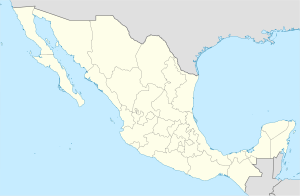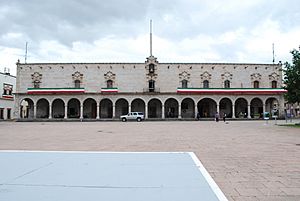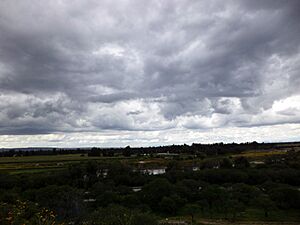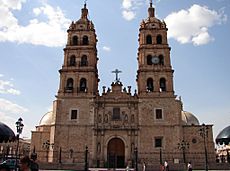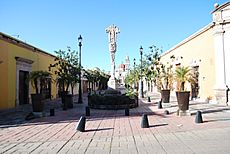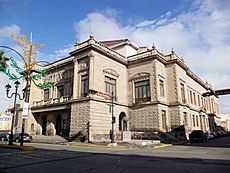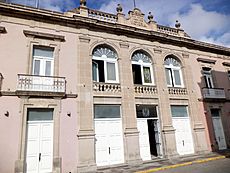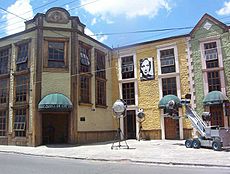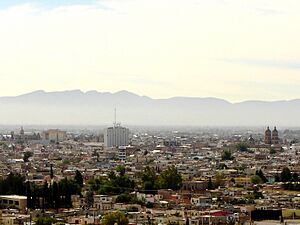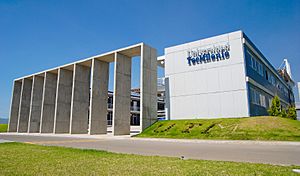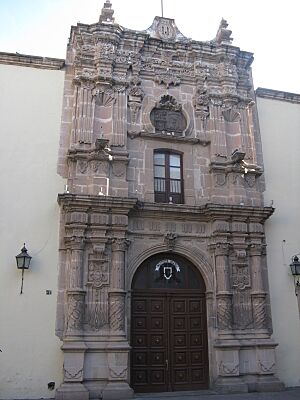Durango (city) facts for kids
Quick facts for kids
Durango
Victoria de Durango
Korian
|
||
|---|---|---|
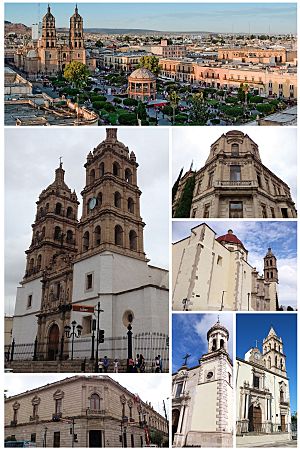
Plaza de Armas, Cathedral Basilica of Durango, Quinta del Aguacate, Santa Ana y la Sagrada Familia Parish, City Hall, San Agustín Temple and San Juan Bautista Parish
|
||
|
||
| Nickname(s):
La Perla del Guadiana, La Tierra del Cine
|
||
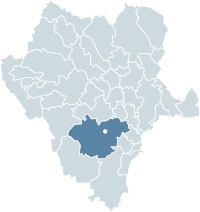
Location of Durango within the State
|
||
| Country | Mexico | |
| State | Durango | |
| Municipality | Durango | |
| Founded | July 8, 1563 | |
| Founded by | Francisco de Ibarra | |
| Elevation | 1,890 m (6.201 ft) | |
| Population
(2020)
|
||
| • City | 616,068 | |
| • Metro | 688,697 | |
| • Demonym | Duranguense/Durangueño | |
| GDP (PPP, constant 2015 values) | ||
| • Year | 2023 | |
| • Total | $12.7 billion | |
| • Per capita | $19,000 | |
| Time zone | UTC−6 (CST) | |
| • Summer (DST) | UTC−5 (CDT) | |
| Area code | 618 | |
| Website | https://municipiodurango.gob.mx/ | |
Durango (Spanish pronunciation: [duˈɾaŋɡo], Southeastern Tepehuan: Korian) is a big city in northern Mexico. It's the capital of the state of Durango and the main city in the Durango municipality. About 616,068 people live here. The city's full name is Victoria de Durango. This name honors Guadalupe Victoria, who was the first president of Mexico and came from this state. Durango sits high up, about 1,890 metres (6,201 feet) above sea level, in a place called the Valley of Guadiana.
Durango was started on July 8, 1563, by a Spanish explorer named Francisco de Ibarra. Long ago, during the time of Spanish rule, it was the capital of a large area called Nueva Vizcaya. This area included much of what is now Durango and Chihuahua states. The city was founded near a mountain called Cerro del Mercado. People thought it had lots of silver, but it turned out to be an important source of iron.
Contents
History of Durango
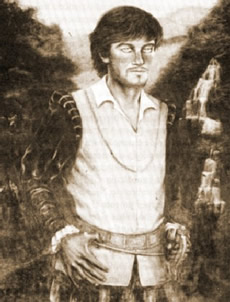
Francisco de Ibarra named the town "Durango" after his hometown in Spain. That name, Durango, comes from the Basque language. He also called the nearby region Nuevo Vizcaya, meaning "New Biscay." In 1826, the city's official name became Victoria de Durango. This was to honor Guadalupe Victoria, Mexico's first president. The city's special shield is also used as the symbol for the state.
Long before the Spanish arrived, the Durango area was a path for different cultures. People called the Nahoas came here about 2,000 years ago. Later, the Zacatecans and Tepehuanos lived here.
The modern city began as a place for mining. Francisco de Ibarra officially founded it on July 8, 1563. He was sent by the Viceroy of New Spain to explore and start the city. The spot was chosen because it was near Cerro de Mercado mountain. People thought it had silver, but it was actually rich in iron. The mountain was named after Captain Ginés Vázquez de Mercado, who found the valley. The area was also good because it had water, wood, and animals for hunting. The city's first streets were laid out by Alonso de Pacheco. The old city center is around the Plaza de Armas and the Cathedral Basilica.
Because Durango was far from Mexico City, it grew quite independently. Some of the first missions in northern Mexico were built here. It became an important stop for travelers heading north. Jesuits, a group of missionaries, also worked here from 1596. They started the Colegio de Guadiana, which was a major school for northern Mexico.
Durango became a church parish in 1620 and an official city on March 3, 1630. The city faced tough times in the 1600s and was almost abandoned. But it started to grow again around 1680. This happened because mines in another town, Parral, were running out. Also, the Spanish government made the area safer. Durango became the capital of the province again on October 10, 1738.
The city was very important in the 1700s because of all the minerals mined nearby. This wealth helped build many grand colonial buildings in the city center.
During Mexico's War of Independence, some important leaders, like Miguel Hidalgo, were executed here on July 17, 1812. Their remains were buried at a church called Santuario de Nuestra Señora de Guadalupe.
In 1867, Benito Juarez, another important Mexican leader, stayed in Durango. The city became an archdiocese, a major church area, on June 23, 1891.
In the late 1800s and early 1900s, Durango was still the state's political center. It was also a hub for selling farm products and handmade goods. City leaders worked to improve things like government buildings, hospitals, and water systems. The city's population grew.
In 1911, Durango joined the Mexican Revolution. The Arrieta brothers led the fight. Domingo Arrieta took control of the city. The Revolution caused problems for farms and factories. On June 18, 1913, rebels took the city and burned businesses. The war led to a long economic downturn. In 1917, Domingo Arrieta became the state governor.
The damage to the city center led to new areas being built outside it. The first new neighborhood, Colonia Obrera, started in 1918. More neighborhoods grew in the 1930s along the train lines. Efforts were made to control this growth until the 1960s.
The population grew a lot in the 1960s and 1970s. Many people moved from farms to the city. This caused the city to spread out to 1,058 hectares. Droughts affecting farming and hopes for new industries were big reasons for this growth.
Filmmaking in Durango started in 1898 with a short film. But in the 1950s, big movies began to be made here. Director Jack Smith found a place called La Ferrería Hacienda perfect for Western films. The first movie filmed here was White Feather. Over the years, many Hollywood and Mexican movies were shot here. Famous stars like John Wayne, Robert Wagner, and Charlton Heston came to Durango. John Wayne even bought a ranch here! More recently, stars like Salma Hayek and Kevin Costner have worked here. The state now tries to attract more filmmakers because of its varied landscapes.
The city continued to grow in the 1970s due to its economy, including movies. Transportation improved with a new airport. Industrial parks were also built.
In the 1980s, new plans tried to manage city growth, but it kept spreading. By 1992, the city covered 5,368 hectares.
From the 1990s to the 2000s, city development focused on paving roads and adding traffic lights. Big ring roads were built in the 2000s and 2010s.
In 2010, Durango became a World Heritage Site. It's part of an old trade route called Camino Real de Tierra Adentro. In the 2010s, many streetlights were changed to LED lights to save energy. In 2013, the city council voted to ban bullfighting. Also in 2013, the city celebrated its 450th birthday!
Durango's Geography
Victoria de Durango is about 1,880 metres (6,170 ft) above sea level. It's in the Valley of Guadiana, in northern Mexico. The city is in the southern part of the state. It borders several other towns like Canatlán and Pueblo Nuevo.
Most of the city's water comes from underground. But cutting down too many trees can affect these water sources.
Weather in Durango
Durango has a semi-arid climate, which means it's usually dry. The weather is mild in the western part of the city. The average temperature there is 15 °C (59 °F), and it gets about 1,600 mm (63 in) of rain each year. In the eastern part, the average temperature is 19 °C (66 °F), with about 500 mm (20 in) of rain.
Winters are mild, with daytime highs around 20.5 °C (68.9 °F) in January. Nights are cold, averaging 1.3 °C (34.3 °F) in January, and it often freezes. Sometimes it can get very hot, over 30 °C (86 °F), or very cold, below −5 °C (23 °F). Winters are usually sunny and dry.
Summers are warm to hot. June is the hottest month, with highs around 30 °C (86 °F) and lows around 14 °C (57 °F). Most of the rain falls in summer, usually starting in mid-June. Afternoon storms are common, sometimes with hail or thunder. July and August are a bit cooler because of the rain. Humidity is higher in summer. Spring and fall have warm days and cool nights with some rain.
Durango gets about 529 mm (20.8 in) of rain each year, with rain on about 59 days. The most rain in one month was in August 1973, with 277.2 mm (10.9 in). The most rain in one day was 108.5 mm (4.3 in) on September 15, 1994. The coldest temperature ever was −12 °C (10 °F) on January 15, 1951. The hottest was 39.5 °C (103.1 °F) on May 28, 1980.
| Climate data for Victoria de Durango (1951–2010, extremes 1941–2000) | |||||||||||||
|---|---|---|---|---|---|---|---|---|---|---|---|---|---|
| Month | Jan | Feb | Mar | Apr | May | Jun | Jul | Aug | Sep | Oct | Nov | Dec | Year |
| Record high °C (°F) | 32.0 (89.6) |
32.0 (89.6) |
36.0 (96.8) |
38.1 (100.6) |
39.5 (103.1) |
38.0 (100.4) |
34.0 (93.2) |
36.8 (98.2) |
37.4 (99.3) |
34.0 (93.2) |
35.0 (95.0) |
32.0 (89.6) |
39.5 (103.1) |
| Mean daily maximum °C (°F) | 20.5 (68.9) |
22.1 (71.8) |
24.5 (76.1) |
27.2 (81.0) |
30.0 (86.0) |
30.4 (86.7) |
28.0 (82.4) |
27.6 (81.7) |
26.7 (80.1) |
25.6 (78.1) |
23.0 (73.4) |
20.5 (68.9) |
25.5 (77.9) |
| Daily mean °C (°F) | 10.9 (51.6) |
12.2 (54.0) |
14.9 (58.8) |
17.7 (63.9) |
20.6 (69.1) |
22.2 (72.0) |
21.0 (69.8) |
20.7 (69.3) |
19.4 (66.9) |
17.4 (63.3) |
14.0 (57.2) |
11.3 (52.3) |
16.9 (62.4) |
| Mean daily minimum °C (°F) | 1.3 (34.3) |
2.4 (36.3) |
5.3 (41.5) |
8.2 (46.8) |
11.1 (52.0) |
14.0 (57.2) |
14.0 (57.2) |
13.7 (56.7) |
12.2 (54.0) |
9.1 (48.4) |
5.0 (41.0) |
2.1 (35.8) |
8.2 (46.8) |
| Record low °C (°F) | −12.0 (10.4) |
−12.0 (10.4) |
−9.5 (14.9) |
−6.0 (21.2) |
1.4 (34.5) |
3.5 (38.3) |
1.3 (34.3) |
7.0 (44.6) |
2.0 (35.6) |
0.0 (32.0) |
−6.0 (21.2) |
−10.0 (14.0) |
−12.0 (10.4) |
| Average precipitation mm (inches) | 11.3 (0.44) |
7.6 (0.30) |
3.8 (0.15) |
6.2 (0.24) |
12.8 (0.50) |
69.3 (2.73) |
121.6 (4.79) |
140.2 (5.52) |
80.7 (3.18) |
51.9 (2.04) |
13.6 (0.54) |
10.0 (0.39) |
529.0 (20.83) |
| Average precipitation days (≥ 0.1 mm) | 1.5 | 0.8 | 0.5 | 1.0 | 1.8 | 8.0 | 14.7 | 14.1 | 8.4 | 4.7 | 1.6 | 1.8 | 58.9 |
| Average relative humidity (%) | 59.5 | 55.5 | 48.9 | 47.2 | 47.9 | 59.6 | 71.0 | 73.2 | 73.8 | 67.0 | 61.6 | 61.6 | 60.6 |
| Mean monthly sunshine hours | 227.5 | 240.6 | 292.1 | 278.4 | 298.2 | 257.5 | 228.5 | 226.3 | 210.7 | 259.5 | 252.7 | 226.1 | 2,998 |
| Source 1: Servicio Meteorologico Nacional | |||||||||||||
| Source 2: World Meteorological Organization (relative humidity and sun 1981–2010) | |||||||||||||
Durango Municipality
The city of Durango is the main government center for 481 other smaller communities. These communities are spread over a large area of 9,259.71 km2 or 3,575.19 sq mi. The local government has a mayor, a syndicate, and seventeen representatives called regidores. In 2015, the municipality had 654,876 people. It is one of 39 municipalities in the state.
The municipality has two main areas: mountains in the west and valleys in the east. Most of the area is covered by forests. You can find wildlife like deer, wildcats, coyotes, and ducks here. The climate is mild. In the western mountains, the average temperature is 15 °C or 59 °F with lots of rain, about 1,600 mm or 63 in. In the east, it's warmer, about 19 °C or 66.2 °F, with less rain, around 600 mm or 24 in.
Most of the municipality's money comes from farming, especially in the eastern valleys. Water comes from rivers like the Tunal and Santiago Bayacora. These rivers also have reservoirs that are used for fun activities. There are also deposits of marble, onyx, and other stones for building.
Famous Landmarks in Durango
Durango is famous for its old buildings, especially those built in the Baroque style. These show how early the Spanish settled here. The historic center has the most old monuments in northern Mexico. This area is centered around the Cathedral and Plaza de Armas. Paseo Constitución is a main street for walking, connecting Hidalgo Garden to Paseo de las Alamedas.

The Cathedral Basilica of Durango started as a small chapel. It became a cathedral in 1621, but the building burned down in 1634. It was rebuilt in the mid-1700s when the city was rich from mining. The church is dedicated to the Immaculate Conception. It has beautiful domes and paintings. Below the cathedral is the Mining Tunnel, a secret passage that is now a museum.
The cathedral faces the city's main square, called Plaza de Armas. This square was created when the city was founded. It has a pink stone kiosk in the middle. The kiosk sells crafts made by art students.
Mercado Gomez Palacio is the city's oldest market, over 200 years old. It still sells fresh produce, candles, traditional clothes, sombreros, and more.
The Ganot-Peschard Museum of Archeology opened in 1998. It helps protect the ancient history of the region's native people. It's recognized as a historical monument.
Durango has several important old churches. The Guadalupe Sanctuary was built in the 1650s. The Remedios Church is on a hill overlooking the city. It was built in 1640 and is one of the oldest churches in the state. Other churches include San Agustin Church and Our Lady of Angels church.
The Regional Museum of Durango is in the El Aguacate Building. This building was built in a French style in the late 1800s. It used to be the home of Governor Francisco Gómez Palacio. It has a garden with an avocado tree, which gave it its nickname. The museum has twelve rooms showing the state's history and nature. It has over 1,000 items, from ancient times to today.
The State Government Palace was once the home of a wealthy miner. It became the government building after Mexico's independence. It has old Baroque designs and newer murals about Mexico's history. It also has the Francisco Villa Museum, honoring a famous person from Durango.
Founders' Plaza is near the State Government Palace. It marks where the city was officially founded. It has a sculpted mural showing the event. It also has a Mirror Monument and a fountain where kids can play. The old Jesuit College nearby is now the main building of the Universidad Juárez de Durango.
The Count Suchil House was built in the 1760s. Its beautiful Baroque front was likely designed by the same person who worked on the cathedral.
The Victoria Theater was built between 1798 and 1800. It's the oldest theater in northern Mexico. It was first a private theater for a wealthy owner. Later, it became a movie house. Now, it's used for plays again.
The City Museum used to be the city government building. It was built in the 1800s. It was once a rich mine owner's home. The building has a mural about the city's history. It also has a collection of movie posters and film equipment.
The Ricardo Castro Theater opened in 1925. It has a French style with stone carvings. The murals inside are by Octavo Rios.
The Angel Zarraga Contemporary Art Museum opened in 1994. It has a collection of paintings and sculptures. It also offers art workshops.
The Durango Folk Culture Museum shows the different cultures of the area. It has five rooms with handicrafts, tools, textiles, and pottery. It also hosts special exhibits.
The Book Museum is part of the State Public Library. It shows how books have changed over time. It has old writing materials like clay tablets and papyrus.
Durango has two museums for young people. El Bebeleche is an interactive children's museum focused on science and technology. The Acertijo Museum is also interactive, with exhibits on science and culture.
Guadiana Park is the main green area in the city. It has sports facilities, fountains, and a theater. Next to it is Sahuatoba Park and Zoo. This park has a small version of the Baluarte suspension bridge. Paseo de Alamedas is a park along the southern edge of the city center. It has willow trees, sculptures, and art exhibits.
The Analco neighborhood is one of the city's oldest and most traditional. It's centered around its church, which was originally a mission. The church's altar and towers were made by Benigno Montoya. An old bridge connects the neighborhood to Paseo de las Alamedas.
The old train station was built in a French style in the late 1800s. It has appeared in many movies filmed in Durango.
The Hacienda de la Ferrería de Flores is about 8 km south of the city. It's a restored old industrial farm that made iron. This site also has important ancient ruins, including pyramid-like structures over 2,000 years old.
The Durango Cultural Complex was once a hospital. It was built in 1899. Later, it became a military building and then a prison. Now, it's a cultural center run by the state government.
The La Familia pedestrian bridge crosses a busy street. It has sculptures of human faces that light up with different colors at night.
Plaza Hito, or 450 Garden, has white sculptures of oak trees. At night, these light up with colors, along with fountains.
The Bicentennial Mural is a large sculpture showing the state's history. It's part of the Bicentennial Convention and Cultural Center. This center celebrates Mexico's 200 years of independence.
Culture and Life in Durango
The city's patron saint is Saint George. His feast day is April 23, celebrated with flowers and candles. People believe he protects them from scorpion stings.
Like many places in Mexico, Durango has an annual Passion Play during Holy Week. This public event was brought back in the mid-1900s.
The Durango National Fair happens every year for 15 days around July 8. It celebrates the city's founding. It starts with a parade and choosing a fair queen. There are sports, cultural events, food, concerts, and exhibits.
The Revueltas Festival is named after a family famous for their art. It features music, literature, and dance events.
The Ricardo Castro Festival is named after a composer from Durango. It offers over 100 events, including book talks, workshops, concerts, and theater.
Beef is a main food in northern Mexico, including Durango. Cheese is also important, made in nearby towns. Because of cold winters and no refrigeration long ago, people developed ways to preserve food. They made canned goods, jams, and dried foods like jerky.
Typical dishes include barbacoa and meat in mole sauce. Caldillo Durangueño is a stew, originally made with deer meat and green chili peppers, but now usually with beef. Asado rojo, made with pork, is another popular dish. But the most famous dish is the gordita. These are thick corn tortillas filled with savory ingredients. They were popular for people working in the fields. Traditional sweets are similar to other parts of Mexico, like crystallized fruits. Mezcal is an important alcoholic drink made here.
Media and News
Durango has many local radio and television stations. Radio stations include Los 40 Principales Durango and La Tremenda. Television stations include Channel 2 (Azteca), Channel 5 (Televisa), Channel 7 (Azteca), Channel 10 (Televisa), and Channel 12 (Televisora de Durango).
Shopping in Durango
The main market is Mercado de Abastos Francisco Villa. It sells candies, pottery, jewelry, and is the biggest supplier of fresh food, dairy, and meats.
Durango's first big shopping mall is Paseo Durango. It has large stores like Liverpool and Suburbia. It also has restaurants, a movie theater, and banking services.
The city also has many smaller shops and boutiques. You can find stand-alone supermarkets from different chains and local grocers.
Business in Durango
The World Bank says Durango, Mexico, is ranked 7th out of 32 cities in Mexico for how easy it is to do business. This ranking looks at how easy it is to start a business, get building permits, register property, and enforce contracts. Durango is ranked 23rd for starting a business, 5th for building permits, 15th for property registration, and 8th for enforcing contracts.
Sports in Durango
Popular sports in Durango are baseball, softball, football (soccer), and basketball.
- In football, the city has a team called Alacranes de Durango (Durango Scorpions).
- In basketball, the city is home to the Durango Lumberjacks (Leñadores de Durango). They play in the Auditorio del Pueblo Gym.
- There's also a minor league baseball team called los Alacranes de Beisbol (Durango Baseball Scorpions). They have a rivalry with the Dorados de Chihuahua.
- There's a semi-professional softball team.
- In American football, there's a semi-professional team called Centuriones de Durango. The ITD Burros Blancos is a college football team.
People of Durango
In 2014, there were 565,300 people in the city and 654,876 in the municipality. Most people in Durango have European backgrounds. There are also people of mixed European and Indigenous heritage, and smaller communities from other parts of the world.
In the late 1800s and early 1900s, some people moved to Mexico from Europe and the Middle East. Many came to Durango from Spain, especially from the Basque Country. Others came from France, Italy, Ireland, Germany, the Netherlands, and Sweden.
During World War II, some people from Eastern Europe (like Russians and Poles) and the Balkans moved here. In the 1990s, Romanians and Ukrainians also arrived.
About 10,000 Plautdietsch-speaking Mennonites live in the Durango municipality. Durango also has communities of retirees from Australia, the United States, and South Africa.
Many Spanish immigrants after the colonial period came from Galicia. Their language, food, and culture were important in the city for much of the 1900s. Recently, descendants of these immigrants have helped bring back Celtic music.
People from Arab and Armenian backgrounds have been important in business and city life since the early 1900s. Smaller groups from Asia, mostly Japanese, Chinese, and Koreans, also live here. Koreans are known for owning family supermarkets.
Religions in Durango
Most people in Durango, like in the rest of Mexico, are Roman Catholic. Less than 10% are Protestants, mostly Charismatics. There are also many Jehovah's Witnesses and Latter-Day Saints. Smaller groups include Jews and Orthodox Christians. About 5,000–7,000 Muslims live in the state, mostly in Victoria de Durango. Durango is the center of the Roman Catholic Archdiocese of Durango. This church area was created in 1620 and became an archdiocese in 1891. It used to cover all of Northern Mexico and parts of the United States. The current archbishop is José Antonio Fernández Hurtado. About 93.3% of the population is Catholic.
Durango's Economy
The city of Durango is the capital and economic hub of a state that mostly relies on farming and raising livestock. It is the biggest city in the state. Locally, the economy also depends on forestry and foreign factories.
There have been efforts to grow the tourism industry here. Most visitors explore the historic center, especially the cathedral, main plaza, old train stations, parks, and museums. Other attractions include old farms (haciendas), natural areas, and movie sets. Some movie sets are now theme parks. In 2010, the city built a cable car that gives amazing views as it goes up Cerro de los Remedios mountain.
Highways connect Durango to Zacatecas, Torreón, Nayarit, and a new highway to Mazatlán. The General Guadalupe Victoria airport has flights within Mexico and to other countries like the United States.
Even though it's not as busy as it was in the mid-to-late 1900s, Durango still attracts filmmakers. It's especially popular for Western movies. Over 120 films have been shot here. The area has movie sets built for this purpose, like Calle Howard and Western Village. The city itself has provided backdrops for "Old Mexico" scenes. Some old sets have been turned into theme parks, like Chupaderos and La Joya, which was John Wayne's old ranch.
Durango has several bus lines, including Omnibus de Mexico and Futura. These are located at the city's bus terminal, General Domingo Arrieta. Within the city, taxicabs are available. Durango is known for having some of the lowest taxi rates in Mexico.
Education in Durango
The municipality has good schools for all ages, from preschool to university. Here are some of the higher education institutions in the city:
- Universidad Politécnica de Durango
- Universidad Tecnológica de Durango
- Universidad Autónoma de Durango
- Universidad TecMilenio (TecMilenio University Durango Campus)
- Universidad España de Durango
- Universidad Del Valle de Guadiana
- Universidad Juarez del Estado de Durango
- Instituto Tecnológico Forestal
- Instituto Tecnológico de Durango
- Escuela Superior de Música
- Facultad de Medicina
The city also has several schools for children of families from other countries:
- Alianza Francesa de Durango (French)
- Colegio Alemán Alexander von Humboldt (German)
- American School of Durango (American)
- Academia Griega de Durango - Ελληνική Ακαδημία (Greek)
- Liceo de Rusia - Русский лицей (Russian)
Transportation in Durango
The city is served by the Durango International Airport. Four airlines fly here, including American Airlines to the United States.
Notable People from Durango
- Francisco Castillo Nájera
- Dolores del Río
- René Elizondo Jr.
- Marlene Favela
- Dolores Guerrero
- Ricardo Moreno
- Ramón Novarro
- Andrea Palma (actress)
- The Revueltas family: José Revueltas, Rosaura Revueltas, Silvestre Revueltas, Fermín Revueltas Sánchez
- Guadalupe Victoria
- Pancho Villa
Sister Cities of Durango
Victoria de Durango is connected with these cities around the world:
 Durango, Spain
Durango, Spain Durango, Colorado, United States
Durango, Colorado, United States Franklin Park, United States
Franklin Park, United States Ningbo, China
Ningbo, China Sacaba, Bolivia
Sacaba, Bolivia Vigo, Spain
Vigo, Spain
See also
 In Spanish: Victoria de Durango para niños
In Spanish: Victoria de Durango para niños



